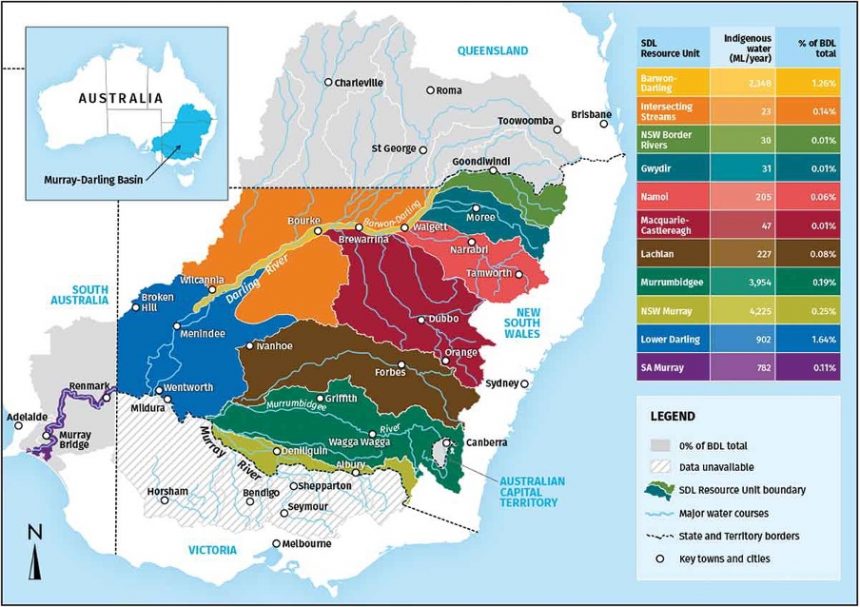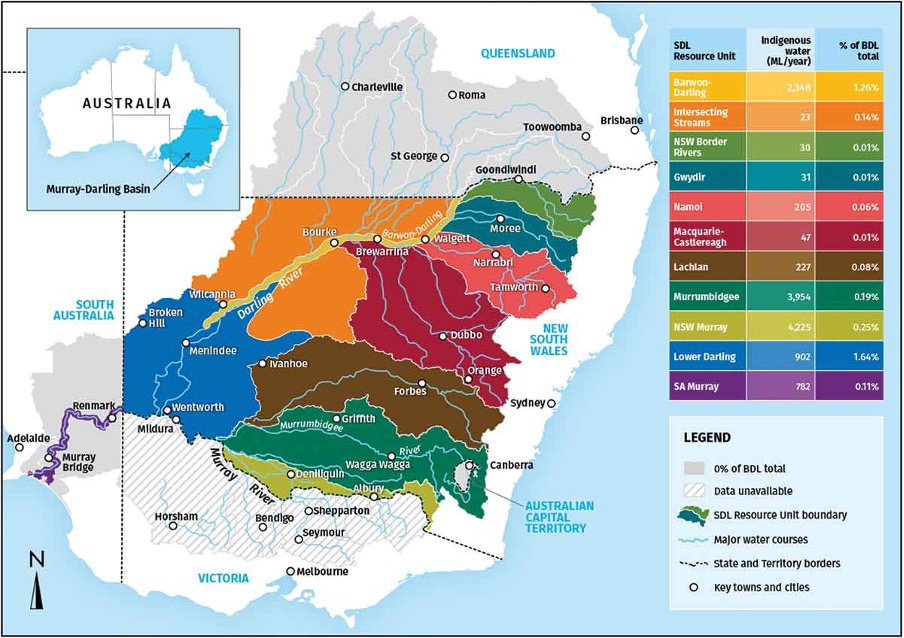Benchmarking Indigenous water holdings in the Murray-Darling Basin

For much of the last 230 years, First Nations of Australia have been dispossessed of water rights and excluded by the institutions that affect how water is used and managed. As Australia comes to terms with this truth, the water injustices Indigenous peoples face are attracting greater research and policy attention. Most recently, for example, the national Closing the Gap policy framework committed Australian governments to set a target to restore water rights to First Nations, alongside a commitment to land restitution.
In responding to Indigenous water rights claims, governments and First Nations need accurate and up-to-date information. Understanding the status quo – how much water Indigenous people or organisations ‘own’ – is a vital prerequisite to measuring changes from policy interventions. Reliable data on Indigenous socioeconomic and demographic conditions is similarly important for aiding water management decisions.
Our recently published work responds to these data needs with a method that enables spatially explicit comparison of water entitlements held by Indigenous organisations within the Murray-Darling Basin (MDB). This method quantified the Indigenous share of water holdings (surface water and groundwater) in relation to recent demographic trends across the MDB, revealing several significant findings. State government water registers do not record the Indigenous status of entitlements so we focused on water holdings of Indigenous organisations which could be readily identified.
Indigenous organisations hold very limited water entitlements of low commercial value
Looking at surface water entitlements, we found 30 Indigenous organisations hold entitlements that provide for 12.8 GL p.a. across the MDB. This constitutes no more than 0.17% of equivalent permitted water take across the entire Basin. The largest portion of this water is held by Indigenous organisations located in the NSW portion of the MDB (93.9%) followed by the South Australian portion (6.1%). There are no Indigenous water holdings in the ACT or the Queensland portion of the MDB. (Victorian data was unavailable but anecdotal evidence indicates some, though again limited, entitlements are held by Indigenous organisations in this state.)

Figure 1 Distribution of Indigenous water holdings and their share of total available water (Baseline Diversion Limit) per SDL (Sustainable Diversion Limit) resource unit.
Our analysis of these Indigenous-held surface water entitlements reveals they are disproportionally located in unregulated systems or are of lower reliability. This impacts how Indigenous organisations can use or benefit from their (limited) water rights (and land).
Turning to groundwater, we found that Indigenous organisations across the MDB hold even fewer entitlements. Just six entitlements were held by six Indigenous organisations which together provide for 556 ML p.a.. Together, these groundwater entitlements constitute 0.02% of what’s available for use across the Basin.
Overall, we found that the market value of these Indigenous-held surface water and groundwater entitlements (approximately A$19.2 million) represents an extremely small portion of the total $16.5 billion market (in 2015-16 terms) – just 0.12%.
The MDB is home to a significant and growing Indigenous population
We found in 2016, the Indigenous population of the MDB was 120,487, representing 5.3% of the total MDB population. While 15.1% of Indigenous people in Australia live in the MDB, only 9.1% of the non-Indigenous population do. Comparison with previous Indigenous population analysis reveals that the population composition of the MDB is becoming more Indigenous over time, and this trend will likely continue.
Contrasting these key population trends with our water baseline findings serves to further demonstrate the inequity in water rights distribution across the MDB.
Significance and implications
Returning water rights to Indigenous control is an essential means of achieving Indigenous water justice. As national and state governments develop policies and programs to improve Indigenous access, our methods and findings will assist in understanding the current inequitable situation, and in setting targets and tracking progress towards a solution.
Further reading
Hartwig, L., Markham, F. andS. Jackson 2021. Benchmarking Indigenous water holdings in the Murray-Darling Basin: A crucial step towards developing water rights targets for Australia, Australasian Journal of Water Resources, doi.org/10.1080/13241583.2021.1970094
